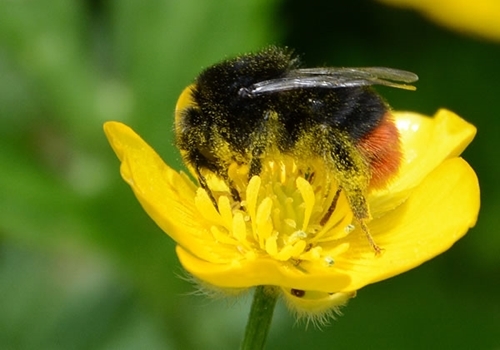By Professor John Holland, Head of the Farmland Ecology Unit
Over the last decade the research on pollinators, especially wild and honey bees has gone exponential, fuelled even more recently by the neonicotinoid issue. Similarly, there has been a huge push through agri-environment schemes, government initiatives and industry to promote the establishment of flower-rich habitats.

Globally this drive to encourage pollinators is easy to understand because 75% of crops used by humans for food are insect pollinated, yet it must be difficult for UK farmers to justify devoting land to flower-rich habitats when most of the lowland is covered by cereal crops and grassland, and of the other widely grown crops, and of the other widely grown crops, field beans is the only one that is dependent on bees for pollination (oilseed rape is mostly wind/self pollinated).
This may explain to some extent the poor uptake of such options in Environmental Stewardship. However, pollinators do need supporting because the wild plants of our hedgerows, woodland and grassland also require insect pollination and this is less than needed as shown at Loddington (see Jacobs et al., 2009).
Also, despite the lack of a comprehensive long-term monitoring scheme for bees, there is evidence that the abundance and range of some species is declining, although there are a few species that are on an upward trend such as the tree bumblebee. Not least flower-rich habitats are quite stunning, they hum with insect life and break up the monotony of cereals and ryegrass. This interest and their ease of management in the long-term were the reasons why farmers involved in the Farm4bio project liked these habitats best, despite their initial reservations.
Pollinator research
The GWCT Farmland Ecology Unit has been involved in pollinator research since the late 1990s through three PhDs that I co-supervised, large collaborative project such as Farm4Bio (2005-10) and QuESSA (2013-17), and several smaller ones that evaluated different flowering mixtures. The simple message from all of these projects was that if flower-rich habitats are established with the species preferred by bees, then they will find them.
So a greater abundance and diversity of flowering plants equals a more bees and more bee species (see Lye et al., 2009; Holland et al., 2015; Wood et al., 2015a, 2017). However, there is always the concern that all we are doing is moving bees around the landscape as they are opportunistic foragers that focus on the most resource rich areas. In Thomas Wood’s PhD project this was evaluated by measuring bumblebee nest densities which are a better measure of productivity than simply assessing abundance along a transect (see Wood et al 2016).
Bumblebee nests are notoriously difficult to find, although help is at hand because all workers in a nest are related, they are effectively sisters, so by taking a DNA sample from these workers we can determine the number of nests in a locality. Tom found almost twice as many bumblebee nests on farms in HLS schemes that had 3% of their land in flower-rich habitats compared to ELS farms with none (see Wood et al., 2015b).
Surprisingly, wild bee diversity which was comprised of bumblebees and solitary bees, was similar on the HLS and ELS farms (see Wood et al., 2015a). This was because remnants of most plants species still survived on farmland and this supporting 104 different bee species. Also the flower-rich habitats typically established contained mostly legumes that are primarily targeted at medium- to long-tongued bumblebees that have declined the most.
Looking ahead
If we are, however, to encourage more solitary bees, then we will need some new flower mixes that contain the flowers they prefer (see Wood et al., 2017). We will also need to determine how we can better manage hedgerows and their hedgebases so that they support a greater abundance and range of flowering species. This will be the focus of another PhD starting this autumn and supported by the Trust.
This summer we started a new project to evaluate how effective the cluster farm approach may be for bumblebees. In this project we aim to measure the nest densities of one common species, the red-tailed bumblebee (Bombus lapidarius), using the molecular approach again.
We are currently seeking funding to conduct the DNA analyses, but what was quite apparent was the lack of flower rich habitats on most of the farms in June and July. Unless extensively grazed downland was present, there was very little elsewhere, occasional patches of clover on grass tracks where they had been cut, yet nothing in the hedgebases apart from a few thistles which some bees do like.
I did wonder what the situation would be like today if the many miles of grassy margins sown under various agri-environment schemes had been sown with a flower-rich mix instead.
References (all GWCT publications)
Holland, J. M., Smith, B.M., Storkey, J., Lutman, P. J. W., Aebischer, N.J. (2015) Managing habitats on English farmland for insect pollinator conservation. Biological Conservation 182, 215-222.
Jacobs, J.H., Clark, S.J., Denholm, I., Goulson, D., Stoate, C., Osborne, J.L., 2009. Pollination biology of fruit-bearing hedgerow plants and the role of flower visiting insects in fruit-set. Annals of Botany 104, 1397–1404.
Lye, G.C., Park, K.J., Osborne, J.L., Holland, J.M. & Goulson, D. (2009) Assessing the value of Rural Stewardship schemes in providing foraging resources and nesting habitat for bumblebee queens (Hymenoptera: Apidae). Biological Conservation 142, 2023-2032.
Wood, T.L., Holland, J.M. and Goulson, D. (2015a) A comparison of techniques for assessing farmland bumblebee populations. Oecologia, 4, 1093-1102.
Wood, T.L., Holland, J.M., Hughes, W.O.H. and Goulson, D. A (2015b) Targeted agri-environment schemes significantly improve the population size of common farmland bumblebee species. Molecular Ecology 24, 1668-1680.
Wood, T.L., Holland, J.M. and Goulson, D. A. (2017) Providing foraging resources for solitary bees on farmland: current schemes for pollinators benefit a limited suite of species. Journal of Applied Ecology, 54: 323-333.